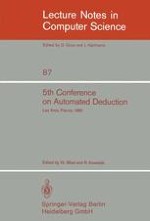1980 | Buch
5th Conference on Automated Deduction Les Arcs, France, July 8–11, 1980
herausgegeben von: Wolfgang Bibel, Robert Kowalski
Verlag: Springer Berlin Heidelberg
Buchreihe : Lecture Notes in Computer Science
Enthalten in: Professional Book Archive
